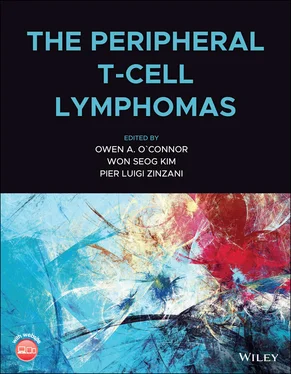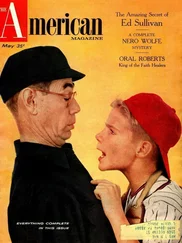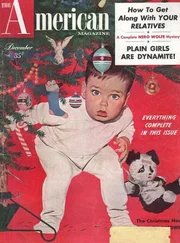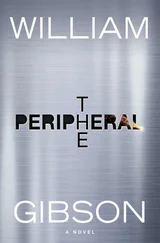Angioimmunoblastic T‐cell Lymphoma
Gene expression profiling and immunohistochemical staining indicate that AITL tumor cells exhibit a T follicular helper (Tfh) phenotype [1]. Tfh cells exist in follicles of lymph nodes and spleen, and support B‐cell survival, proliferation, migration, and differentiation [2]. Tfh phenotypes, both in the context of normal helper T cells and in AITL cells, are determined by expression of co‐stimulatory molecules such as inducible T‐cell co‐stimulator (ICOS) and programmed cell death 1, as well as by chemokine receptors, such as C‐X‐C motif chemokine receptor 5 and C‐X‐C motif chemokine ligand 13, and membrane metalloendopeptidase, such as CD4 and CD10, and a key transcription factor governing Tfh development, namely, B‐cell lymphoma 6 protein (BCL6, [1]). Several animal models have been established to assess AITL pathogenesis.
ROQUIN is a ubiquitin ligase that reportedly limits expression of Icos by binding to Icos mRNA and promoting its degradation [3]. Icos protein is critical for Tfh cell survival. The missense (M199R) sanroque mutation in the Roquin gene ( Roquin san) increases Icos expression by blocking Icos mRNA degradation [3]. Ellyard et al. reported that mice heterozygous for the Roquin sanallele exhibited dysregulated Tfh cells and develop AITL‐like tumors [4]. However, to date ROQUIN gene alterations have not been found in human AITL [5].
The Mouse Models Recapitulating Human Angioimmunoblastic T‐cell Lymphoma Genomic Features
AITL samples harbor recurrent somatic mutations in genes encoding epigenetic regulators such as tet methyl cytosine dioxygenase 2 ( TET2 ), DNA methyl transferase 3 alpha and isocitrate dehydrogenase 2 [6]). All of these mutations occur frequently in numerous hematologic malignancies, whereas TET2 mutations are detected more frequently in PTCL exhibiting a TFH phenotype compared to those without a TFH phenotype [7]. The p.Gly17Val mutations in the ras homologue family member A ( RHOA) (designated as the G17V RHOA mutations) are specifically found in up to 50–70% of AITL and its related lymphomas with a Tfh phenotype [6, 8, 9].
Homozygous Tet2 gene trap(Tet2 gt/gt ) mice harbor a gene‐trap vector in the Tet2 second intron [10]. Muto et al. reported that 70% of Tet2 gt/gtmice developed T‐cell lymphomas with Tfh‐like gene expression patterns around 67 weeks old [10]. DNA methylation analysis revealed that lymphoma cells of Tet2 gt/gtmice exhibited increased methylation at transcriptional start sites, gene bodies and CpG islands, and decreased hydroxymethylation at transcriptional start site regions [10]. Hypermethylation of the first intronic silencer region of the Bcl6 gene reportedly has been known to inhibit CCCTC‐binding factor (CTCF) binding to this locus and promotes Bcl6 transcription [11]. Density of methylation was increased in lymphoma cells of Tet2 gt/gtmice compared with control CD4+ cells [10]. Upregulation of Bcl6 , encoding a master transcriptional regulator in Tfh development finally results in outgrowth of Tfh‐like cells in Tet2 gt/gtmice [10]. These results suggest overall that decreased Tet2 function contributes to AITL initiation. Notably, hypermethylation of the corresponding region in BCL6 locus is also found in human PTCL samples with TET2 mutations [12].
To determine effects of G17V RHOA expression, multiple independent G17V RHOA model mice have been established using either retroviral transduction [13], knock‐in [14], or transgene [15, 16] approaches. These G17V RHOA model mice did not develop AITL‐like lymphomas, although increase of Tfh cell populations [14, 15] and autoimmunity [15] were observed in some lines of mice. Therefore, the appearance of oncogenic phenotypes may require additional gene mutations.
Because the G17V RHOA mutations are almost always accompanied by loss‐of‐function TET2 mutations in human AITL samples [6], mice expressing the G17V RHOA mutant in Tet2 ‐null background were established by using distinct approaches [13–16]. Briefly, Zang et al. transduced Tet2 ‐null T cells with retrovirus harboring G17V RHOA , and they performed adoptive transfer of these cells into T‐cell receptor (TCR ) α ‐deficient mice [13]. Cortes et al. crossed G17V RHOA conditional knock‐in (cKI), Tet2 conditional knockout (cKO), and CD4CreER T2mice, in which tamoxifen induces expression of G17V RHOA mutant and deletion of Tet2 gene in T cells, and then transplanted bone marrow cells of these mice into irradiated C57BL/6 mice, followed by immunization with sheep red blood cells [14]. Ng et al. crossed G17V RHOA transgenic mice with Tet2 cKO x Vav‐Cre mice , lacking Tet2 gene in hematopoietic cells, and OT‐II TCR mice, followed by immunization with NP‐40‐Ovalbumin [15]. Nguyen et al. crossed G17V RHOA transgenic mice with Tet2cKO x Mx1‐Cre mice, lacking Tet2 gene in hematopoietic cells with injection of polyinosinic:polycytidylic acid (pI:pC) [16]. Model mice established by Zang et al. revealed skewed T‐cell differentiation such as increase of TFH cells and decrease of T regulatory cells, and abnormal expansion of CD4 +T cells [13]. Mice established by Cortes et al., Ng et al., and Nguyen et al. developed AITL‐like lymphomas after 25, 38, and 48 weeks, respectively [14–16]. Zang et al. also reported that TET2 loss and G17V RHOA expression synergistically inactivates FoxO1: Tet2 loss leads to increase of methylation in FoxO1 promoter that suppress its transcription in CD4 +T cells, whereas the G17V RHOA mutant elevates phosphorylation of FoxO1 and promotes its translocation from the nucleus to the cytosol, where it undergoes proteasomal degradation [13]. This agrees with findings of mTORc1‐associated gene expression by Ng et al. in G17V RHOA ‐expressing tumor cells, as FoxO1 suppresses mTORc1 signaling [15]. Likewise, Cortes et al. reported that G17V RHOA activates PI3K‐mTORc1 signaling in CD4 +T cells dependent on ICOS‐ICOSL signaling [14]. Accordingly, tumor cell proliferation was inhibited by everolimus, a mTOR inhibitor [15] and duvelisib, a PI3K inhibitor [14], supporting the idea that ICOS‐PI3K‐mTORc1 signaling drives Tfh cell expansion in mice. Fujisawa et al. reported that hyperactivation of TCR signaling is an essential downstream event of the G17V RHOA mutant in vitro : the G17V RHOA mutant binds to and activates VAV1, a key component of TCR signaling [17]. Nguyen et al. reported that phosphorylation of VAV1 and activation of TCR signaling were also observed in murine tumor cells [16]. Dasatinib, a multikinase inhibitor effectively prolonged the survival of mice through inhibiting the TCR signaling pathway [16].
PDX Models of Angioimmunoblastic T‐cell Lymphoma
A PDX model was established by inoculating primary AITL tumor cells and microenvironmental reactive cells into NOD/Shi‐ scid, IL2Rgamma null(NOG) mice [18]. The immunohistological features of tumors in PDX mice recapitulated those of AITL patients. Additionally, human immunoglobulin G/A/M was detected in the sera of PDX mice, indicating that patient‐derived B and plasma cells were activated by AITL tumor cells in mice. Their analysis suggests that the function of TFH cells in AITL cells was reconstituted in the PDX mice.
Читать дальше












